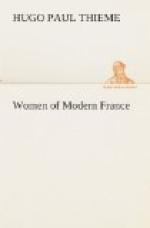The association of La Rochefoucauld, the Cardinal de Retz, the Chevalier de Mere, Mme. de La Fayette, and Mme. de Sevigne, was responsible for almost everything elevating and of interest produced in the seventeenth century. Of that highly intellectual circle, Mme. de Sevigne was the leading spirit by force of her extraordinary faculty for making friends, her wonderful talent as a writer, her originality and her charming disposition. She gave the tone to letters; M. Faguet says that her epistles were all masterpieces of amiable badinage, lively narration, maternal passion, true eloquence. More than that, they are important sources of historical knowledge, inasmuch as they contain much information concerning the politics of the day, and furnish an excellent guide to the etiquette, fashions, tastes, and literature of the writer’s period.
Mme. de Sevigne was the most important figure of the time, being to that third prodigiously intellectual epoch of France what Marguerite de Navarre was to the sixteenth century, and the Hotel de Rambouillet to the beginning of the seventeenth century. She represented the style, esprit, elegance, and gout of this greatest of French cultural periods. Her life may be considered as having had two distinct phases—one connected with an unhappy marriage and the other the period of a restless widowhood.
Marie de Rabutin-Chantal, Marchioness of Sevigne, was born at Paris, in 1626; at the age of eighteen months she lost her father; at seven years of age, her mother; at eight, her grandmother; at ten, her grandfather on her mother’s side; she was thus left with her paternal grandmother, Mme. de Chantal, who had her carefully educated under the best masters, such as Menage and Chapelain (court favorites), from whom she early imbibed a genuine taste for solid reading; from these instructors she learned Spanish, Italian, and Latin.
In 1644, she was married to the Marquis Henri de Sevigne, who was killed six years later in a duel, but who had, in the meantime, succeeded in making a considerable gap in her immense fortune, in spite of the precautions of her uncle, the Abbe of Coulanges. Henceforward, her interests in life were centred in the education of her two children; to them she wrote letters which have brought her name down to posterity as, possibly, the greatest epistolary writer that the history of literature has ever recorded.
Mme. de Sevigne was but nineteen years old when, after the marriage of Julie d’Angennes, the frequenters of the Hotel de Rambouillet began to disperse, and she was in much demand by the successors of Mme. de Rambouillet. While the women of the reign of Louis XIII.—Mmes. de Hautefort, de Sable, de Longueville, de Chevreuse, etc.—were exceedingly talented talkers, they were poor writers: but in Mme. de Sevigne, Mme. de La Fayette, and Mlle. de Scudery both arts were developed to the highest degree.




